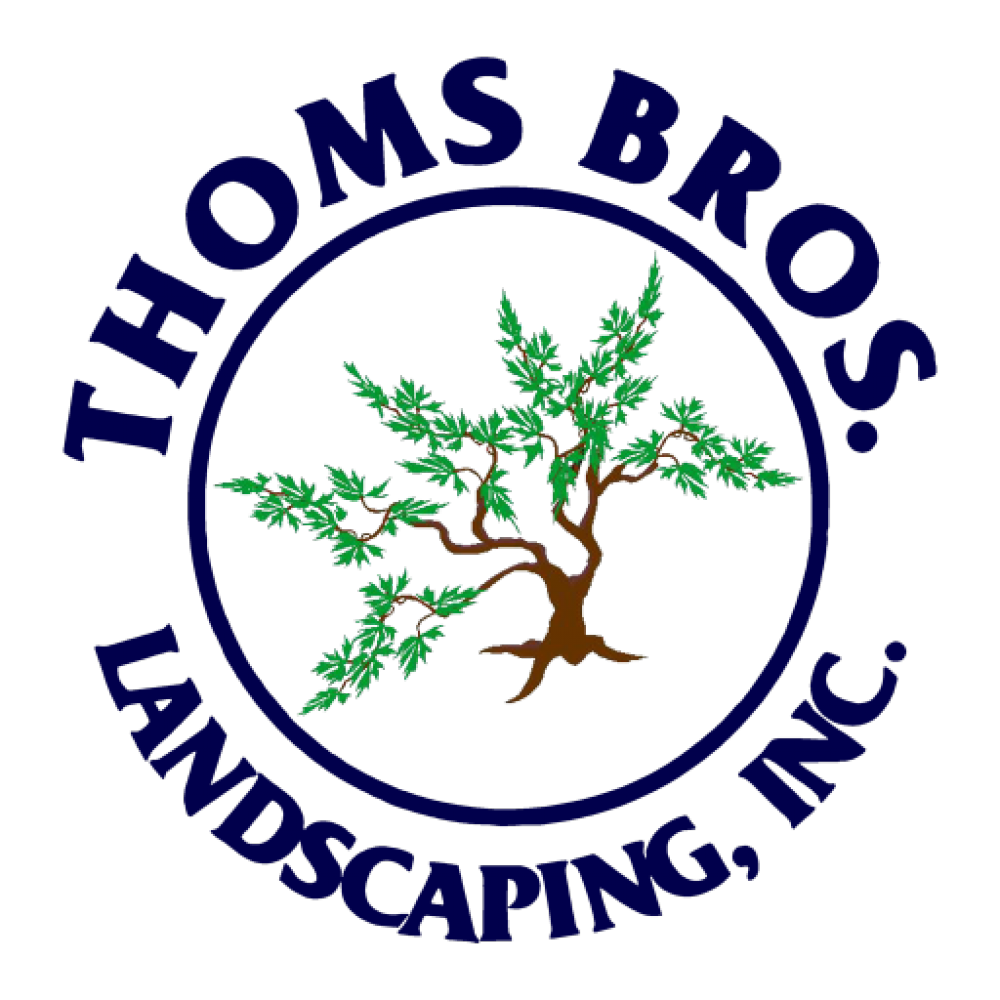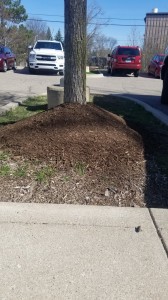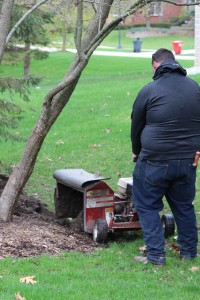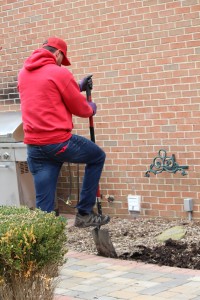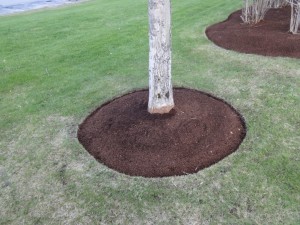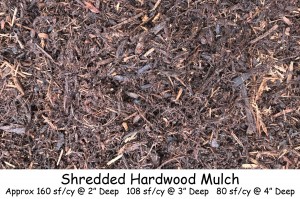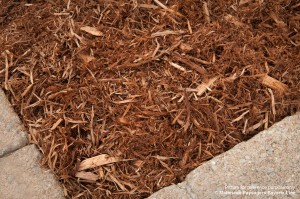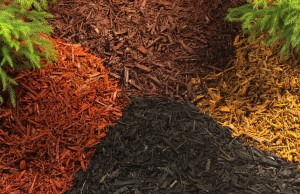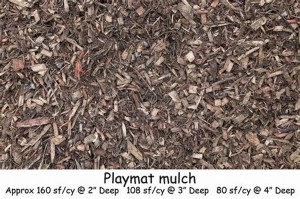Spring is finally here! And you are looking to mulch your planting beds. Do you do it yourself? Do you hire the kid down the street? Or, do you hire a reputable, horticulturally minded landscape firm? When applied properly, mulch can help maintain soil temperature and conserve water. Additionally, it can help prevent root compaction and reduce lawn mower and string trimmer damage. Organic mulches can also help improve the soil’s physical structure and fertility as it breaks down over time.
But hiring the cheapest company to install could lead to multiple issues. Besides possibly lacking the best appearance, the biggest problem with incorrect mulch installation is volcanoes around tree rings. Mulch volcanos are unsightly and the excessive mulch on the trunk causes moisture to build up, creating ideal conditions for insect pests, diseases and decay. If more than four inches of mulch is used, it can end up repelling water and thick layers of mulch can also prevent air from reaching the roots, suffocating the plant. The decline tends to happen slowly over time, but it is inevitable. The proper way to mulch around a tree appears more like a doughnut with mulch 3 to 6 inches away from the trunk. The depth of the ring should be two to four inches max.
Also too much mulch can be used if a landscaping crew is not measuring the current amount of mulch in a bed before applying more. It is natural for customers to want to have a fresh look and beds can lose some of their color in the sun. “Those that decompose faster must be replenished more often,” says Martha Smith, a University of Illinois Extension horticulture educator. “Here lies the problem, some mulches, such as cypress mulch, remain intact for years but they turn a grey-tan color. People prefer the ‘fresh’ look of new mulch and top dress annually, not considering the existing mulch depth.”
At Thoms Bros, we believe our highly trained staff jobs separate us from most companies in the following ways:
1. Bed Edging – next to existing, permanent edging such as steel, aluminum and plastic edging, Thoms Bros. pulls away old mulch and dirt so we can install new fresh mulch up to the edging without it running over. We do the same thing along hard surfaces such as concrete and brick pavers. With a natural edge, Thoms Bros. uses a 5” deep edger blade with its bed edger to give a deep cut. Then we fine rake just enough mulch into the trench to prevent weeds but still give the defined look.
2. Prepping – Thoms Bros. cleans out debris out of beds and makes sure existing weeds are eradicated. This would either be completed by physically removing and or using a post-emergent herbicide.
3. Distribution – Thoms Bros. makes sure the correct depth of mulch is installed. On average a four-inch depth is recommended in most situations. Depending on frequency and types of mulch used, could mean a one to four-inch installation of mulch. The team member using a hard rake makes sure depth is correct and guides other team members in locating piles.
4. Tree Rings – Mulch depth and distribution is extremely important as mentioned earlier in this article. If necessary, Thoms Bros. will remove existing mulch as to prevent depth to be at the desired level. Mulch is distributed in away as not to go above the tree crown.
5. Fine Tuning – Following the team member responsible for distribution, another team member will use a metal tine leaf rake to make sure mulch is spread nicely leaving no humps. They will also make sure bed edges to finished to perfection. They will also hand rake around perennials and other sensitive plant material. Hand distribution will take place around ground cover that is not established..
6. Clean-up – Thoms Bros. removes mulch from turf areas and makes sure any pavement is clear of mulch and debris residue. If we are using a colored mulch, we will try to avoid using driveway surfaces, but if not possible, the driveway will be pressure washed.
Mulch Choice
Speaking of organic mulch, another challenge can be choosing the proper mulch material for the job. There are many materials to choose from when it comes to organics including hardwood chips, shredded bark, shredded leaves and pine straw. Organic mulch tends to be preferred over inorganic mulches as they do break down over time and add organic matter to the soil.
Inorganic material such as lava rock, pebbles or rubber mulch are all options and don’t break down over time so they don’t have to be replaced but they also don’t provide any nutrients to the soil.
Finely textured organic mulches tend to decompose more quickly than coarse material. Long-term use of the same type of mulch can change surface soil pH levels. Mulches like pine straw can cause the soil surface to increase in acidity while hardwood bark mulch can cause surface soil to become too alkaline. Inorganic mulches like limestone gravel can also change the pH and can kill acid-loving plants.
Some of the most common types of organic mulches are:
1. Double Processed Hardwood Mulch – is the best for those plants. It decomposes into a rich, sweet-smelling black dirt, and it looks ever so tidy while doing it. Plus, hardwood bark mulch is the best for amending your soil. This is our most common used mulch as it is very economical, natural looking and gives the best results. It is dark in color and fine in texture.
2. Cedar Mulch – Cedar oil is a natural insect repellant. That same fragrant aroma that keeps moths and pests out of your cedar chest or closet, works to keep pests away from your plants when you mulch with cedar. In areas where termites are a problem, that particular characteristic makes it worth paying the higher cost for cedar mulch. However, this type of mulch does have its downsides. It decomposes very slowly, adding only trace amounts of nutrients back to your soil. On the other hand, this does mean that cedar mulch is quite long lasting.
3. Cypress Mulch – like cedar, is a natural insect repellent. It’s a good pest repellent, but it’s more expensive than other mulches perhaps due to its attractive blonde color. In addition, the process of harvesting cypress trees can cause untold environmental damage.
4. Pine Bark Mulch is a fine ground of Pine Tree bark. It is known to be a great soil conditioner and does a great job at retarding weed growth. The aroma of Pine Bark Mulch will immediately make you think that you have escaped to Northern Michigan!
5. Colored Enhanced Mulch (black, brown, gold & other selections) gives a cleaner, more uniform look to extensive mulching. Colored mulch comes in red and black and some specialty colors. It’s more expensive than non-colored mulch and the dyes fade in the sun, or fade unevenly, eventually ruining the appearance. The dye is environmentally safe and non-toxic, but can transfer to your hands when you spread the mulch.
6. The Certified Playground Mulch / Engineered Wood Fiber that has been certified for safe use on playgrounds and under and around playscapes. The mulch has passed impaction, compaction, and wheelchair accessibility tests, meeting or exceeding the American Society for Testing and Materials (ASTM).
